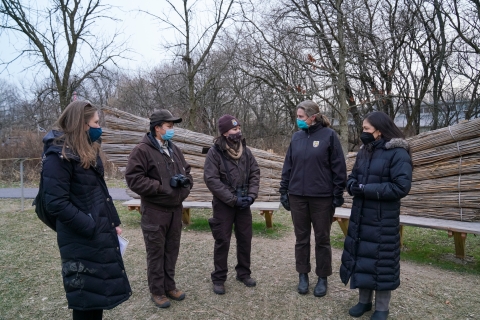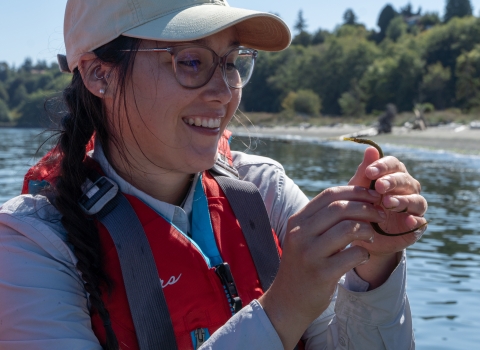Who is a hunter? Or, more specifically, what does a hunter look like?
In the U.S., the answers to those questions have been the same for centuries. But it’s time they changed. The U.S. Department of the Interior and Fish and Wildlife Service are taking action to create safe, inclusive, and equitable access to outdoor recreation and nature’s benefits for all Americans — regardless of what they look like, or where they come from.
Just one example of this important work is John Heinz National Wildlife Refuge’s mentored archery hunt program, an effort to break down barriers and intentionally engage and inspire a new generation of black and brown hunters.
Keeping the tradition alive
A Google search of “American hunter” yields images with a common thread: white and male. The covers of outdoor-themed magazines and show something similar — camouflage-adorned, perhaps bearded, white men.
There are statistics to back these observations. According to the U.S. Fish and Wildlife Service’s 2016 National Survey of Fishing, Hunting, and Wildlife-Associated Recreation, 97% of all U.S. hunters are white — with non-white hunters representing just 3%.
It’s clear that the sport, though a cornerstone of American culture and integral to conservation, is facing a crisis of relevancy. To keep the tradition alive, the message that hunting is open to Black, Indigenous, and People of Color (BIPOC) communities needs to reach those audiences.
That’s exactly what the team at John Heinz National Wildlife Refuge in Philadelphia has set out to do.
More than conservation
When the Philadelphia refuge first opened its doors to the mentored archery deer hunt program in 2019, the conservation need was evident.
Over the years, the refuge has seen a notable increase in the number of white-tailed deer. Too many deer, without the predators needed to counterbalance, has resulted in a population beyond what the land and its resources can support. At the same time, deer over-browsing on native plants has created space for harmful, non-native invasive species invasive species
An invasive species is any plant or animal that has spread or been introduced into a new area where they are, or could, cause harm to the environment, economy, or human, animal, or plant health. Their unwelcome presence can destroy ecosystems and cost millions of dollars.
Learn more about invasive species to establish and become a predominant vegetation.
That’s where the hunt comes in. Working with the Pennsylvania Game Commission, National Deer Association, and Friends of John Heinz National Wildlife Refuge, the refuge program provides those with little to no experience an opportunity to participate in a managed deer hunt under the training and guidance of experienced mentors.
From an ecological standpoint, it’s a cost-effective way of managing wildlife populations and maintaining healthy habitat.
But the team at John Heinz sees it as something even more valuable: a way of introducing underserved urban communities to an activity they’ve never had the chance to try — or perhaps never felt welcome to.
Creating space
“It’s my belief that, in the conservation world at large, one reason we’ve seen this decline in interest in hunting…is that the hunting community has only marketed hunting to white America,” Lamar Gore, the refuge manager at John Heinz says.
That’s not to say that people of color don’t hunt, he stresses. The problem is that a lack of representation, whether it be on the magazine rack or the first page of an internet search, has resulted in a hunting culture that fails to be truly inclusive.
There are, of course, other factors at play, including economic disparity, lack of access to rural areas, and fear or unease in outdoor spaces. Many of these apply to the neighborhoods the refuge targets for this program.
“What we’re trying to do is create a relationship with the community,” Gore says. “The community we’ve identified is historically excluded, and majority black and brown. We’ve targeted that group to engage with.”
Hunting 101
Beginning with a well-rounded orientation, participants — selected through a lottery — are taken through the conservation history of hunting, deer biology and habitat, crossbow instruction, and hunting safety and ethics, and meat processing. All the essentials.
According to Garrett White, a biological technician at the refuge who helps lead the program, this educational component addresses any barriers that the would-be hunters face.
“We help identify what licenses are out there, what kind of clothing and tools they need, the ‘how-to’ on hunting,” White says.
The added support of trained mentors — volunteers with prior hunting experience who want to pay it forward — not only creates a safe hunt for all, but also instills confidence and camaraderie in the new hunters.
When they’re properly trained and ready, the mentees and their mentors gear up in the early morning, head into the forest to settle into their hunting blinds, and wait patiently for the perfect shot to line up.
Making connections
As to be expected, the results of the hunt vary from person to person. Some mentees take one deer — occasionally two — while others are a little less lucky. However, the program partners ensure that no one leaves empty-handed. Following the hunt, the Pennsylvania Game Commission donates venison — confiscated from poachers — to those mentees who don’t harvest a deer.
The staff has enjoyed plenty of rewarding moments over the last few years: mentees returning to serve as mentors; individuals venturing out on hunts beyond the refuge; and, above all else, the simple joy people experience when taking in the sights and sounds of nature.
Everybody comes to the program for a different reason, White explains — whether it’s the hunting, time spent with family, access to fresh and locally sourced meat, or just being outside. His favorite moments are when he can help guide new hunters into successfully making those connections.
The refuge plans to close out the season in late March with a big community potluck. Gathering all the mentees and their families, mentors, and partners, the group will cook their game, share stories from the hunt, and continue building that sense of camaraderie and trust that the refuge aims for.
A model for urban conservation
John Heinz National Wildlife Refuge isn't alone in its efforts to make nature a place for everyone. The Biden-Harris administration’s “America the Beautiful” initiative, a national effort to conserve and restore American lands and waters, includes a commitment to address the inequities communities of color face in connecting to the outdoors. Secretary of the Interior Deb Haaland and Principal Deputy Director of the U.S. Fish and Wildlife Service Martha Williams visited the refuge in January to discuss the important role urban wildlife refuges play in advancing this goal.
“As we work to address inequitable access to the outdoors for communities of color and underserved communities, places like the John Heinz National Wildlife Refuge serve as a model of what it looks like to create inclusive spaces that all people, regardless of their background, can access,” Secretary Haaland said.
Looking to the years ahead, Gore and the team at John Heinz are eager to continue using programs like the mentored hunt to build trust with the community just beyond their gates — and they’ve got their work cut out for them.
“We will keep working at making sure our hunters feel safe and welcome, and my hopes are that we will have a larger crowd of black and brown people knocking at the door to hunt, fish, take a kayak tour, or just come to walk and take in the sounds of all natural lands.”








